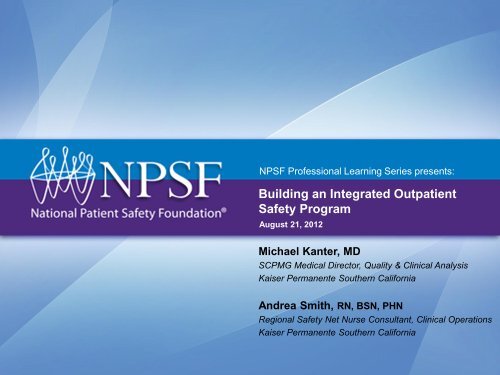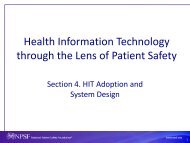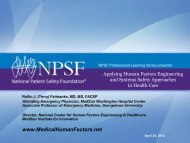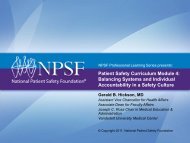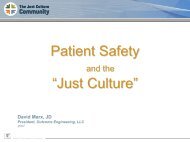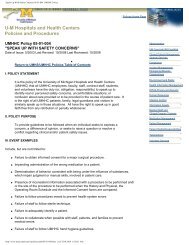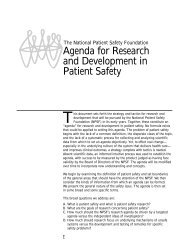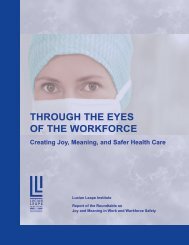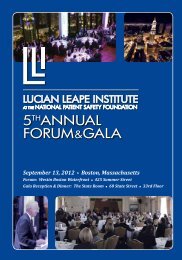Download the presentation slides - National Patient Safety Foundation
Download the presentation slides - National Patient Safety Foundation
Download the presentation slides - National Patient Safety Foundation
- No tags were found...
You also want an ePaper? Increase the reach of your titles
YUMPU automatically turns print PDFs into web optimized ePapers that Google loves.
Participant Notification, cont.Continuing Education*:This educational activity offers 1.0 contact hours for physicians, nurses, pharmacists and healthcare executives.PharmacyInquisit ® is accredited by <strong>the</strong> Accreditation Council for Pharmacy Education as a provider of continuingpharmacy education.This activity will provide 1.0 ACPE Contact Hours under UAN 0232-9999-12-147-L05-PExecutivesInquisit is authorized to award 1.0 hours of pre-approved ACHE Qualified Education credit for this program towardadvancement or re-certification in <strong>the</strong> American College of Healthcare Executives. Participants in this programwishing to have <strong>the</strong> continuing education hours applied toward ACHE Qualified Education credit should indicate<strong>the</strong>ir attendance when submitting application to <strong>the</strong> American College of Healthcare Executives for advancementor recertification.*Continuing education credits are only available for live webcasts. A post-event survey must be completedwithin 7 days of participation to receive continuing education credits.3NPSF Professional Learning Series
DisclosureFaculty DisclosureMichael Kanter, MD and Andrea Smith, RN have no significant financialinterest / arrangement with any organization(s) that could be perceived as areal or apparent conflict of interest with <strong>the</strong> subject matter of <strong>the</strong> <strong>presentation</strong>.Acknowledgement of Commercial SupportThere was no commercial support received for this activity.4NPSF Professional Learning Series
Learning ObjectivesUpon completing this session, attendees will be able to:• Identify where opportunities might exist in <strong>the</strong>ir organizations to systematicallyaddress patient safety issues outside of <strong>the</strong> traditional inpatient setting• Outline specific patient populations within four primary areas of outpatientsafety: medication monitoring, potentially harmful interaction avoidance,necessary follow-up care, and diagnosis• Plan an outpatient safety program by creating a series of centralized safetynets to catch important tests not properly followed up, drugs not properlymonitored, and missed follow-up care5NPSF Professional Learning Series
KPSC Regional Outpatient <strong>Safety</strong> Net:Speaker IntroductionsMichael Kanter, MDMedical DirectorQuality & Clinical AnalysisSou<strong>the</strong>rn CaliforniaAndrea Smith, RNRegional <strong>Safety</strong> Net Nurse ConsultantClinical OperationsSou<strong>the</strong>rn California6
KPSC Regional Outpatient <strong>Safety</strong> Net:Session Objectives• Attendees will identify where opportunities might exist in <strong>the</strong>ir operations tosystematically address patient safety issues outside of <strong>the</strong> traditional inpatientsetting.• Attendees will learn about specific patient populations within 4 primary areas ofoutpatient safety:» medication monitoring,» potentially harmful interaction avoidance,» necessary follow up care, and» diagnosis detection.• Attendees will be able to develop an outpatient safety program by creating aseries of centralized safety nets to catch important tests not properly followedup, drugs not properly monitored and missed follow up care.7
Kaiser Permanente – <strong>National</strong>Nation’s largest nonprofit health plan8.7 million members14,000 physicians156,000 employees600-700 residents & fellows32 hospitals420 medical office buildings8 Regions. Serving 9 States and D.C.8
Kaiser Permanente Sou<strong>the</strong>rn California• 13 service areas• 150 medical offices• 5,300 physicians•18,300 nurses•57,000 employees•3.5 million members9
Kaiser Permanente – <strong>National</strong>Nation’s largest nonprofit health planKaiser<strong>Foundation</strong>HP/H, Inc.<strong>National</strong>PartnershipAgreementThePermanenteFederation, LLCArticles of FederationRegionalHealth PlansMedicalServiceAgreements/MOUsPermanenteMedical Groups1010
<strong>Patient</strong> <strong>Safety</strong> Background:To Err is HumanPublished by <strong>the</strong> IOM in 1999, an estimated98,000 deaths per year were identified.Most errors were identified in <strong>the</strong> inpatientsetting.Medication errors were mentioned 70 times anddiagnostic errors mentioned 2 times.11
<strong>Patient</strong> <strong>Safety</strong> Background:Types of Medical ErrorsProceduralErrorsDiagnosticErrorsMedicationErrors12
<strong>Patient</strong> <strong>Safety</strong> Background:Characteristics of Diagnostic ErrorsStructure• Some structural metrics• Presence of EMRProcess• Few process metrics• No bundles to measure• No “time outs” to measureOutcomes• Hard to measure outcomes• Outcomes have long delays13
<strong>Patient</strong> <strong>Safety</strong> Background:Types of Diagnostic ErrorsFailure tofollow upabnormaltestsAvailabilityheuristicAnchoringheuristicInformationoverloadDiagnosticerrorsFramingeffectsVisualdiagnosticerrorsPrematureclosureBlindobedience14
<strong>Patient</strong> <strong>Safety</strong> Background:Outcomes of Diagnostic ErrorsGenerally requires chart review by expertswho may disagreeMay take a long follow up period to findmissed diagnosisWith few exceptions, missed diagnoses donot have <strong>the</strong> same immediate emotionalimpact as wrong site surgery errors15
<strong>Patient</strong> <strong>Safety</strong> Background:Traditional Medication ErrorsFive Rights ofMedicationAdministration•Right Medication•Right <strong>Patient</strong>•Right Dose•Right Route•Right Time16
<strong>Patient</strong> <strong>Safety</strong> Background:Types of Medication ErrorsMedication Errors also occur as a result of:Failure to administer when indicatedDisregard for allergies, drug-drug interactions,drug-disease interactions, drug-age interactionsFailure to monitor drugs that are givenappropriately17
KPSC “Complete Care” Approach to Quality:OverviewCompleteCareEvery patient. Every place.Every visit. Every time.Every One.18
KPSC “Complete Care” Approach to Quality:Overview19
KPSC Regional Outpatient <strong>Safety</strong> Net:OverviewA regional program that systematically identifies members whohave Outpatient <strong>Safety</strong> Risks, usingA small, centralized team with limited clinical scopecapacity and clerical support to catch small groupsof members who fall through cracks, andSeveral automated electronic tools consistentlyused by accountable frontline staff to track certainabnormal results for all members.20
KPSC Regional Outpatient <strong>Safety</strong> Net:Areas of Primary FocusProjects focus onOutpatient <strong>Safety</strong> throughdiagnosisdetectionmedicationmonitoringpotentiallyharmfulinteractionsnecessaryfollow-up care21
KPSC Regional Outpatient <strong>Safety</strong> Net:Current ProjectsDiagnosisDetectionMedicationMonitoringPotentiallyHarmfulInteractionsNecessaryFollow UpCareDigoxin(K+ and SCr)APAP OverusePSA Electronic <strong>Safety</strong> NetKidney Disease(Repeat Ser Creatinine)Anti-Convulsants(drug levels)Falls + TCAs+FOBT (FIT) Electronic<strong>Safety</strong> NetACEs/ARBs(Lytes and SCr)Dementia + TCAsAbnormal Pap Electronic<strong>Safety</strong> Net (KPACT)Post-TAB Counseling/ Birth ControlPost-TAB Counseling /Birth ControlColon Cancer(Iron Deficiency Anemia+ No colonoscopy)Diuretics(K+ and SCr)Amiodarone(Preventive monitoringplan)Gemfibrozil + StatinsAmiodarone + SimvastatinAbdominal AorticAneurysm TrackingPost SplenectomyImmunizations22
KPSC Regional Outpatient <strong>Safety</strong> Net:Prostate Specific Antigen (PSA) <strong>Safety</strong> NetOur First <strong>Safety</strong> NetTo ensureNecessary Follow Up Care23
Necessary Follow Up Care: PSA <strong>Safety</strong> NetBackgroundProstate Cancer (CaP)• Most common cancer among men• 2 nd leading cause of cancer deathProstate Specific Antigen (PSA)• Screening test for CaP• Assess management of existing CaP patientsOver 300,000 PSA tests annually (KPSC)• 50,000 tests for screening24
Necessary Follow Up Care: PSA <strong>Safety</strong> NetRisk Management ProblemDelays in cancerdiagnosisPotential LitigationRiskManagementProblemUnknown number fallingthrough <strong>the</strong> cracksNo known fix25
Necessary Follow Up Care: PSA <strong>Safety</strong> NetResults8,076 patients for case management.3,833 patients received Urologyappointments.2,204 patients underwent prostate biopsy.745 Prostate Cancers diagnosed betweenApril 2006 and December 2009.Zero claims related to missed abnormalPSA’s26
Necessary Follow Up Care:+FOBT (FIT) <strong>Safety</strong> NetIn <strong>the</strong> United States, an alarming number of abnormal FOBTs (home stool kitsto screen for colorectal cancer) are never followed up.One study (Carlson et al, 2010)* found 44% of positive FOBTs were neverfollowed up within 5 years.Modeled after <strong>the</strong> PSA <strong>Safety</strong> Net, <strong>the</strong> electronic +FOBT <strong>Safety</strong> Net tool isused by GI department staff to track abnormal results.* Carlson CM, Kirby KA, Casadei MA, Partin MR, Kistler CE, Walter LC. “Lack of follow-up after fecal occult blood testing inolder adults: inappropriate screening or failure to follow up?” Arch Intern Med. 2011 Feb 14;171(3):249-56. Epub 2010 Oct 11.27
Diagnosis Detection:Unrepeated Creatinine 2010-201128
Medication Monitoring:Digoxin 2009 - 201129
Medication Monitoring:ACEs, ARBs & Diuretics Case Study57 year old male with history of DiabetesMellitus, dyslipidemia and hypertension .Taking 12.5 mg hydrochlorthiazide (HCTZ)daily. Member presents to Primary CarePhysician’s office with complaints ofinsomnia, headache and emotional stress.• Completed Routine Labs (electrolytes) as a result ofBatch Lab upload and outreach efforts.• Electrolyte Results showed sodium of 119.• Numerous attempts were made to advise patient topresent to ER for evaluation of critical lab result.• Ultimately admitted to hospital for observation with asodium level of 117 revealed on repeat lab results.• HCTZ discontinued.• Discharged home in stable condition with a diagnosisof hyponatremia.30
Medication Monitoring:ACEs, ARBs & Diuretics 2010-201131
Medication Monitoring:ACEs, ARBs & Diuretics100,000Frequency10,0001,00010010Labs Resulted 81, 015Abnormal SodiumResults# %Abnormal Low Na 3,832 4.7%Abnormal High Na 319 0.4%132
Medication Monitoring:ACEs, ARBs & DiureticsFrequency100,00010,0001,000100101Labs Resulted 80,103AbnormalPotassium Results# %Abnormal Low K+ 4,956 6.19%Abnormal High K+ 2,331 2.91%Potassium Results33
Medication Monitoring:Anti-convulsants 2010-201134
Percent of EligibleMedication Monitoring:Combined HEDIS Results YE 2010Annual Monitoring for <strong>Patient</strong>s on Persistent Medication - Combined95Antelope ValleyBaldwin Park90DowneyFontanaKern CountyLos Angeles85Orange CountyPanorama CityRiversideSan Diego80South BayWest Los Angeles752009YE 2010P1 2010P2 2010P3 2010P4 2010P5 2010YERolling Time PeriodWoodland HillsREGIONTarget = 86%35
Percent of EligibleMedication Monitoring:Combined HEDIS Results YE 201196Annual Monitoring for <strong>Patient</strong>s on Persistent Medication - Combined928884802010YE 2011M02 2011M04 2011M06 2011M08 2011M10 2011M12Rolling Time PeriodAntelope ValleyBaldwin ParkDowneyFontanaKern CountyLos AngelesOrange CountyPanorama CityRiversideSan DiegoSouth BayWest Los AngelesWoodland HillsREGIONTarget = 87%3636
Medication Monitoring:Amiodarone Preventive Monitoring ProtocolLab & Procedure Test Baseline Every 6monthsEvery 12monthsCommentsPulmonary Function Tests X X 30% AbnormalChest X-Ray X 30% AbnormalThyroid & Liver FunctionTestsXXStatin Conversions X 2,119 members on Statin34.6% Discontinued35.0% ConvertedElectrocardiogram (EKG) X XOphthalmic examDermatology examNeurology examReminder inevery letter tolook forchangesRefer to specialist forconsult37
Potentially Harmful Interactions:Acetaminophen (APAP) OveruseProject Overview• FYI message in <strong>the</strong> electronic chart (withconversion table) to last ordering provider• Members identified as taking >4gm APAP dailybased on Rx fill patternsResults• 946 FYI Message Encounters Sent• 736 APAP Overusers Identified One Month Later• 210 Members no longer identified as Overusers• 22.2% Reduction in Potential harm38
Potentially Harmful Interactions:Falls or Dementia + TCAsFYI to following provider for members with documented Fall or Dementia diagnosis andtaking Tri-cyclic Antidepressants (TCAs)39
Necessary Follow Up Care:Abdominal Aortic Aneurysm Tracking• A Three - Part Program• Part 1: Best Practice Advisory• Part 2 – Follow Up According to Clinical Practice Guidelines• Part 3 - TrackingAbdominal Aorta Diameter< 3 cm normal, no fur<strong>the</strong>r action needed> 3.0 cm code for condition, place on problem list, and treat with a statin3.0 - 3.9 cm annual ultrasound4.0 to 5.9 cm routine referral to vascular surgery> 6.0 cm urgent referral to vascular surgery4040
Necessary Follow Up Care:Post Splenectomy Immunizations• Administrative data + Natural Language Processing (NLP) used to identify•Members with a history of splenectomy•Who are missing one or more of <strong>the</strong> following:Recommended immunization schedule for aspleniaPneumococcal vaccine, polysaccharide(Pneumovax 23)Age > 55: Meningococcal polysaccharidevaccineAge 2-55: Meningococcal conjugatevaccineHaemophilus influenza type b conjugatevaccineOne doseOne dose2 - dose primary series administered2 months apartOne doseSingle booster after 5 years, if initial vaccinegiven before age 65May need revaccination after 5 yearsMay need revaccination after 5 yearsNo revaccination needed• Leverages <strong>the</strong> use of a Physician’s Assistant4141
Diagnosis Detection:Iron Deficiency Anemia w/o ColonoscopyWHO• M/W 55-75 (not terminally ill)• No colonoscopy in past 10 years• GFR > 60• Iron deficiency:• Men MCV < 80, HB < 14, RBC < 4.7M• Women MCV< 80, HB < 12, RBC < 4.2MWHAT• Outpatient <strong>Safety</strong> Net Staff Gastroenterologist will conduct chart review• Recommend diagnostic colonoscopy to treating provider via EMR4242
Potentially Harmful Interactions:Gemfibrozil + StatinsWHO• Members take gemfibrozil AND• ANY statinWHAT• Chart review by Regional Outpatient <strong>Safety</strong> Net Pharmacist• Message to MD via EMR with pended order for Labs and new Rx• Regional Outpatient <strong>Safety</strong> Net Pharmacist informs member once approvedWHY• Reduce potentially harmful drug-drug interaction4343
ConclusionsEstablishing an Outpatient <strong>Safety</strong> NetProgram allows <strong>the</strong> proactiveidentification of safety issues that canavoid/reduce adverse outcomes for <strong>the</strong>entire member population, includingthose who never present to <strong>the</strong> hospital.44
Questions?DiagnosisDetectionMedicationMonitoringPotentiallyHarmfulInteractionsNecessaryFollow UpCareDigoxin(K+ and SCr)APAP OverusePSA Electronic <strong>Safety</strong> NetKidney Disease(Repeat Ser Creatinine)Anti-Convulsants(drug levels)Falls + TCAs+FOBT (FIT) Electronic<strong>Safety</strong> NetACEs/ARBs(Lytes and SCr)Dementia + TCAsAbnormal Pap Electronic<strong>Safety</strong> Net (KPACT)Post-TAB Counseling /Birth ControlColon Cancer(Iron Deficiency Anemia+ No colonoscopy)Diuretics(K+ and SCr)Amiodarone(Preventive monitoringplan)Gemfibrozil + StatinsAmiodarone + SimvastatinAbdominal AorticAneurysm TrackingPost SplenectomyImmunizations45
46Appendices
Process from idea to implementation2) ProposalReviseProject ProposalNo1) IdeaProject DesignDevelopment ofProject ProposalPropose Project toDr. Kanter forapprovalApproval ofProject Proposalfrom Dr. KanterYesFeedbackLoopPropose Project toSMES Panel forapprovalYesApproval ofSMES Panelfrom Dr. KanterProposeSMES Panel toDr. Kanter forapprovalAssembleSMES PanelReviseProject ProposalNoApproval ofProject ProposalFrom SMES PanelNoReviseSMES Panel3) SMES PanelFeedback &ApprovalYes4) AnnouncementEmailDeployAnnouncementemail 7 days priorto Project launchdateDid any majorconcerns arise?NoYesReview concernswith Dr. Kanterand SMES PanelLaunch ProjectRevise Projectmaking suggestedchangesReport results toDr. Kanter and SMES Panelas appropriate5) ProjectLaunch47
48Example of project launch announcement
49Example of FYI message encounter in KPHC
50Example of provider interaction and support
51Example of letter to member
Thank you!
Submit a Question53NPSF Professional Learning Series


